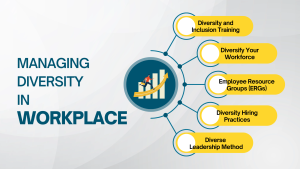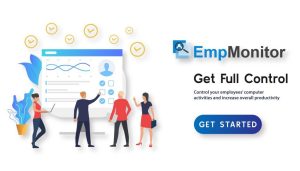Picture this: you walk into a party and realize everyone there looks and acts exactly like you. Well! It might attract you for a while but you cannot spend hours. It would feel boring, right? That’s because diversity is the spice of life and is just as important in the workplace.
Managing diversity in the workplace means creating an environment where everyone feels valued and appreciated, no matter their race, gender, age, or background. It’s not just a “nice-to-have” – it’s an essential ingredient for any successful business.
But diversity management can be challenging. It requires effort and commitment from the organization, from top-level executives to entry-level employees. It means promoting diversity through policies and initiatives and being willing to have difficult conversations about bias and inclusion.
In this blog post, we will explore the importance of managing diversity in the workplace and provide practical tips for companies looking to create a more inclusive environment. We’ll discuss the benefits of diversity and the challenges and barriers that can make it difficult to manage.
Whether you’re a seasoned HR professional or just starting your career, this blog post is for you! Managing diversity is essential for creating a workplace where everyone can thrive, and we’re excited to share our insights with you.
So grab a cup of coffee and explore more about managing workplace diversity!
In a hurry? Listen to our podcast instead!
What Is Diversity in the Workplace?
Diversity refers to the differences among people, including their backgrounds, experiences, and perspectives. It encompasses characteristics such as race, gender, age, religion, sexual orientation, and abilities. Diversity means creating a culture where individuals with different backgrounds and perspectives are valued and included in the workplace.
Now, you might wonder why diversity management in workplace is so important. Well, there are many reasons!
- Firstly, diverse teams bring various perspectives to the table, which can lead to better decision-making and problem-solving.
- Secondly, companies with diverse workforces are more innovative and creative, with a broader range of ideas to draw from.
- Thirdly, having a diverse workplace is essential for attracting and retaining top talent, as individuals want to work in environments where they feel valued and included.
So, there you have it – the basics of diversity and its importance in the workplace. Let’s explore five ways companies manage variety to create inclusive and thriving work environments!
5 Ways How Companies Are Managing Diversity In The Workplace
Well! If you are wondering how to manage diversity in the workplace, then let us tell you — it’s simple to implement. Let’s know how other companies are working with diverse workforce cultures!
Here are five ways that companies are managing a diverse workforce to create inclusive and thriving work environments:
Diversity and Inclusion Training
Building a diverse and equitable workplace culture isn’t just a moral imperative; it also benefits your employees and the bottom line. It is when you foster an inclusive environment where everyone feels valued and supported. You create a sense of belonging that benefits not just your company but also the communities in which you operate.
So, don’t just do it because it’s the right thing; do it because it’s suitable for everyone involved.
This type of training is designed to increase awareness and understanding of different cultures, backgrounds, and perspectives. It helps employees learn how to interact respectfully and effectively with people from diverse backgrounds and how to create an inclusive workplace culture. This type of training can take many forms, including online modules, in-person workshops, and coaching sessions. Managing diversity in the workplace can cover topics such as unconscious bias, cultural awareness, and effective communication.
For example, Google offers a program called “Unconscious Bias” that teaches employees how to recognize and overcome their biases and create a more inclusive work environment. The training has been credited with helping to increase diversity in the company’s workforce.
Adaptable To Workforce Diversity
Well! Transitioning to a diverse work model is a significant decision for any company. Let’s take an example.
A company could offer flexible working hours to better accommodate employees with children or mobility restrictions. This can make it easier for them to commute to work during off-peak hours or work from home when needed. Another option could be to post job ads in places where minority groups are more likely to see them, like on community bulletin boards or at local events.
By taking these proactive steps, companies can create a more diverse and inclusive workforce. It’s not just the right thing to do, but it’s also good for business. Diverse teams bring unique perspectives and ideas to the table, leading to better problem-solving and innovation.
Similarly, a company can implement a hybrid workforce system. Let’s understand how one can embed such a work model effectively without hampering employees’ productivity.
A hybrid work model refers to a setup where employees can work from the office or remotely based on their individual requirements and the company’s needs. This arrangement allows for greater flexibility and enables employees to work in a location most conducive to their productivity.
But did you know that managing a hybrid workforce can help your company grow better?
As we mentioned earlier, managing diversity in the workplace can have numerous benefits for your company. However, it can also come with its own set of challenges. That’s where employee monitoring tools like EmpMonitor can help.
EmpMonitor is an employee monitoring software that allows you to analyze employee activity, productivity, and engagement, regardless of whether they work in the office or remotely. Here are a few ways EmpMonitor can help you achieve better results with your hybrid workforce:
Increased productivity: EmpMonitor allows you to monitor employee activity and identify areas where productivity can be improved. For example, if you notice an employee spending too much time on non-work-related websites or applications, you can address the issue and help them refocus on their tasks.
Improved collaboration: EmpMonitor also includes features promoting remote team members’ collaboration, such as screen sharing and chat capabilities. This can help ensure your team works together efficiently and effectively, regardless of location.
Enhanced security: With EmpMonitor, managing diversity in the workplace becomes easier! You can monitor employee activity to ensure sensitive company data is not shared or accessed improperly. This can help protect your company from data breaches and other security threats.
Better employee engagement: EmpMonitor includes features like employee feedback and surveys, which can help you better understand your employees’ needs and concerns. It can help you create a more supportive and engaging workplace, improving employee retention and morale.
Employee Resource Groups (ERGs)
ERGs are voluntary groups of employees who come together based on shared characteristics or interests, such as race, gender, or sexual orientation. These groups provide a sense of community and support for employees and opportunities for personal and professional development. ERGs can also offer a platform for employees to advocate for change and raise awareness about issues that are important to them.
For example, Microsoft has over 100 Employee Resource Groups representing a wide range of diverse communities, such as Blacks at Microsoft, Women at Microsoft, and LGBTQ+ at Microsoft. These groups offer opportunities for members to connect, share experiences, and advocate for change.
Diversity Hiring Practices
Companies are implementing diversity hiring practices to ensure their workforce is diverse and inclusive. Workforce diversity in management includes things like advertising job openings to a diverse range of candidates, using blind hiring techniques to reduce bias, and training hiring managers on how to avoid unconscious bias.
For example, Deloitte has implemented a program called “Blind Hiring,” which removes identifying information such as name, gender, and education from resumes to help reduce unconscious bias in hiring.
Diverse Leadership
Having leaders and executives from diverse backgrounds is important because various leaders bring different perspectives and ideas to the table, leading to better decision-making and innovation. It can also create a culture of inclusivity and openness within the company.
For example, Johnson & Johnson has implemented a program called “Leading Inclusively,” which trains leaders to be more aware of unconscious bias and to create a more inclusive work environment. The program has helped to increase diversity in the company’s leadership ranks.
Benefits Of Managing Diversity In The Workplace
Now that we’ve explored how companies manage diversity in the workplace let’s talk about the benefits of doing so! There are many reasons why companies should prioritize diversity and inclusion, including:
Improved Decision-Making: When you have diverse employees with different backgrounds and perspectives, you’re more likely to make better decisions. It is because diverse teams are better at problem-solving and tend to consider a wider range of perspectives when making decisions.
Increased Creativity and Innovation: When you have employees with different backgrounds and experiences, you’re more likely to develop new ideas and solutions. Managing diversity in the workplace fosters creativity and innovation, which can lead to new products, services, and ways of doing things.
Better Employee Morale: Employees who feel valued and included are likelier to be happy and engaged in their work. It can lead to improved employee morale, which can lead to higher productivity, better customer service, and lower turnover.
Enhanced Company Reputation: Companies prioritizing diversity and inclusion tend to have a better reputation with customers, employees, and investors. It can increase customer loyalty, higher employee retention rates, and better access to funding and investment opportunities.
Challenges In Managing Workplace Diversity
While managing diversity in the workplace can bring many benefits, there are also challenges that companies may face. Some of these challenges include:
Resistance to Change: Change is hard, and some employees may resist the idea of diversity and inclusion. They may feel it’s unnecessary or takes away from the “traditional” way of doing things. This resistance can make it difficult for companies to implement diversity initiatives and create a more inclusive work environment.
Bias and Stereotyping: Even with the best intentions, prejudices, and stereotypes can creep into the workplace. This can make it difficult for employees from diverse backgrounds to feel included and valued. It can also lead to discriminatory practices, such as hiring or promotion decisions based on stereotypes rather than merit.
Communication Barriers: When you have employees from different cultural backgrounds, communication barriers may make it difficult to work together effectively. This can lead to misunderstandings, missed deadlines, and other problems.
Also Read:
10 Best Practices For Managing Diversity In The Workplace 2023
Inclusive Growth: Groth Of Employee Engagement And Productivity
A Comprehensive Guide To Increase Employee Engagement – 2023: EmpMonitor
Conclusion
In conclusion, managing diversity in the workplace is becoming increasingly important for companies worldwide. As we move towards a more globalized and interconnected society, diversity and inclusion are no longer just buzzwords – they’re essential components of a successful business.
Looking toward the future, it’s clear that companies that prioritize diversity and inclusion will be better positioned to succeed. By fostering a more diverse and inclusive workplace, companies can improve decision-making, boost innovation, enhance employee morale, and enhance their overall reputation.
But the work continues. As we continue to face new challenges and opportunities in the coming years, companies must remain committed to managing diversity in the workplace. This means continuing to educate employees on the benefits of diversity and inclusion, implementing new policies and initiatives to promote diversity, and addressing any challenges that arise along the way.
By doing so, we can create a more equal and inclusive workplace that benefits everyone – employees, companies, and society. So let’s continue to work towards a future where diversity and inclusion are not just buzzwords but integral parts of our workplaces and communities.















